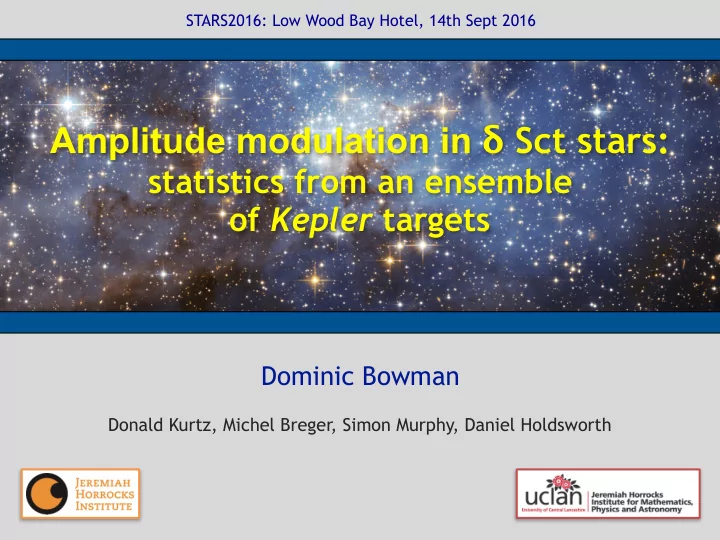

STARS2016: Low Wood Bay Hotel, 14th Sept 2016 Amplitude modulation in δ Sct stars: statistics from an ensemble of Kepler targets Dominic Bowman Donald Kurtz, Michel Breger, Simon Murphy, Daniel Holdsworth
STARS2016 Introduction The δ Sct stars δ Sct stars lie in the classical instability strip: 6400 ≤ T eff ≤ 8900 K. 983 δ Sct stars continuously observed by Kepler for 4 yr. credit: JCD (Bowman 2016) Dominic Bowman Amplitude modulation in δ Sct stars 2/16
STARS2016 Introduction The δ Sct stars High-frequency signals in LC Kepler data are suppressed in amplitude. credit: JCD (Bowman 2016) Dominic Bowman Amplitude modulation in δ Sct stars 3/16
STARS2016 Introduction What is amplitude modulation? e.g., KIC 7106205 4-yr time span (Bowman & Kurtz 2014) Dominic Bowman Amplitude modulation in δ Sct stars 4/16
STARS2016 Introduction What is amplitude modulation? e.g., KIC 7106205 4-yr time span ν 1 ν 3 high frequency resolution (Bowman & Kurtz 2014) Dominic Bowman Amplitude modulation in δ Sct stars 5/16
STARS2016 Introduction What is amplitude modulation? e.g., KIC 7106205 4-yr time span ν 1 ν 3 high frequency resolution (Bowman & Kurtz 2014) Dominic Bowman Amplitude modulation in δ Sct stars 6/16
STARS2016 Introduction Defining significant amplitude modulation Each δ Sct is defined as being an AMod or a NoMod star. e.g., KIC 7106205 (Bowman et al. 2016) Dominic Bowman Amplitude modulation in δ Sct stars 7/16
STARS2016 Results AMod: KIC parameter statistics AMod NoMod 61.3 per cent of 983 δ Sct stars are AMod stars, with significant amplitude modulation in at least a single pulsation mode. (Bowman et al. 2016) Dominic Bowman Amplitude modulation in δ Sct stars 8/16
STARS2016 Results Constant amplitude stars ν 1 e.g., KIC 2304168 (Balona & Dziembowski 2011) Period ratio of ν 1 and ν 2 is 0.7725, ν 2 associated with fundamental and first overtone radial modes T eff = 7220 ± 270 K log g = 3.67 ± 0.19 (Huber et al. 2014) NoMod star (Bowman et al. 2016) Dominic Bowman Amplitude modulation in δ Sct stars 9/16
STARS2016 Results Variable amplitudes ν 1 e.g., KIC 4733344 ν 2 Period ratio of ν 2 and ν 3 is 0.7678, ν 3 associated with fundamental and first overtone radial modes. T eff = 7210 ± 260 K log g = 3.50 ± 0.23 (Huber et al. 2014) AMod star (Bowman et al. 2016) Dominic Bowman Amplitude modulation in δ Sct stars 10/16
STARS2016 Results Non-linearity: combination frequencies Non-linear distortion model: Higher amplitude pulsation modes have "higher order" combinations: (Kurtz et al. 2015; Balona 2016) . k l a t ' s c i p á P r e t é P . f . c Combination terms: n ν i ± m ν j (Bowman 2016) Dominic Bowman Amplitude modulation in δ Sct stars 11/16
STARS2016 Results Non-linearity: models e.g., KIC 4733344 (Bowman et al. 2016) Theoretical prediction of resonant coupling between pulsation modes (Dziembowski 1982; Buchler et al. 1997). Q: Coupling or a combination frequency? ν 1 = ν 2 ± ν 3 ϕ 1 = ϕ 2 ± ϕ 3 A 1 = µ c (A 2 A 3 ) µ c << 1 favours non-linear distortion model µ c ~ 1 favours resonant mode coupling (Breger & Montgomery 2014) Dominic Bowman Amplitude modulation in δ Sct stars 12/16
STARS2016 Results HADS stars δ Sct stars with peak-to-peak Pulsate in fundamental and/or first light excursions greater than overtone radial modes 0.3 mag (McNamara 2000) . (McNamara 2000). ν 1 Typically slow rotators with: v sin i < 40 km s -1 ν 2 (Breger 2000; McNamara 2000; Rodríguez et al. 2000). Post-main sequence stars? (Petersen & Christensen-Dalsgaard 1996). Only 2 of 983 Kepler δ Sct stars are HADS stars! (Bowman et al. 2016) Dominic Bowman Amplitude modulation in δ Sct stars 13/16
STARS2016 Results HADS stars � 1 82 × 10 − 6 yr − 1 dP � es, , o ~ 1 Observed: P dt ... pulsational non-linearity. ν 1 ν 2 (Bowman et al. 2016; Bowman 2016) Dominic Bowman Amplitude modulation in δ Sct stars 14/16
STARS2016 Conclusions Conclusions • The δ Sct stars exhibit diverse pulsational behaviour. • Amplitude modulation is common among δ Sct stars, but not ubiquitous. • Models can be used to quantify the strength of non- linear mode coupling. • The HADS stars are rare and exhibit non-linearity, which may explain why these stars differ to typical δ Sct stars. Jeffery & Saio (2016) Dominic Bowman Amplitude modulation in δ Sct stars 15/16
STARS2016: Low Wood Bay Hotel, 14th Sept 2016 Amplitude modulation in δ Sct stars: statistics from an ensemble of Kepler targets Thank you for your attention Dominic Bowman
Recommend
More recommend